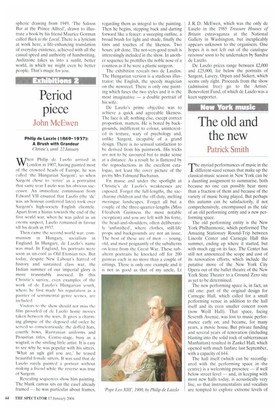Period piece
John McEwen
Philip de Laszlo (1869-1937): A Brush with Grandeur Christie's. until 22 January
When Philip de Laszlo arrived in London in 1907, having painted most of the crowned heads of Europe. he was called the Hungarian Sargent': so when Sargent chose to 'retire' as a portraitist that same year Laszlo was his obvious successor. An immediate commission from Edward VII ensured that Laszlo (the 'de' was an honour conferred later) took over Sargent's high-society English clientele. Apart from a hiatus towards the end of the first world war, when he was jailed as an enemy suspect, Laszlo remained in favour till his death in 1437.
Then came the second world war. communism in Hungary, socialism in England. In Hungary, de Laszlo's name was mud. In England, his portraits were soon as un-cool as Old Etonian ties. But today, despite New Labour's hatred of history and sustained class war, the Indian summer of our imperial glory is more reasonably assessed. In this Christie's survey, even examples of the work of de Laszlo's Hungarian youth, where he first made his reputation as a painter of sentimental genre scenes, are nclu ded.
Visitors to the show should not miss the. film provided of de Laszlo home movies taken between the wars. It gives a charming glimpse of the deposed old order he served so conscientiously: the doffed hats, courtly bows, Ruritanian uniforms and Proustian titles. Centre-stage, busy as a wagtail, is the smiling little artist. It is easy to see why he was popular with his sitters. 'What an ugly girl you are,' he teased beautiful female sitters. It was said that de Laszlo rarely painted a portrait without making a friend while the reverse was true of Sargent.
Revealing sequences show him painting. The blank canvas sits on the easel already framed — he was particular about frames, regarding them as integral to the painting. Then he begins, stepping back and darting forward like a fencer: a sweeping outline, a broad brush for light and shade, finally the tints and touches of the likeness. Two hours: job done. The not-very-good result is interestingly included in the show. In another sequence he prettifies the noble nose of a countess as if he were a plastic surgeon.
The exhibition reveals two de Laszlos. The Hungarian version is a studious illustrator; the English, the speedy magician on the newsreel. There is only one painting which fuses the two styles and it is the most imaginative — a double portrait of his wife.
De Laszlo's prime objective was to achieve a quick and agreeable likeness. The face is all; nothing else, except correct proportion, matters. He is bored by backgrounds, indifferent to colour, uninterested in texture, wary of psychology and, unlike Sargent, incapable of a grand design. There is no sensual satisfaction to be derived from his paintwork. His tricks are not to he savoured but to make sense at a distance. As a result he is flattered by the reproductions in the excellent catalogue, not least the cover picture of the pretty Mrs Edmund Buchanan.
Fn masse and under the spotlight at Christie's de Laszlo's weaknesses are exposed. Forget the full-lengths, the saccharine children and the off-duty, melting meringue landscapes. Forget all but a couple of the three-quarter-lengths (Miss Elizabeth Guinness the most notable exception) and you are left with his forte, the head-and-shoulders, often deliberately 'unfinished', where clothes, still-life props and backgrounds are not an issue.
The best of these are of men young, old, and most poignantly of the subalterns on leave from the Great War. These subaltern portraits he knocked off for 200 guineas each in no more than a couple of sittings. There is only one example and it is not as good as that of my uncle, Lt J.R. D. McFwen, which was the only de Laszlo in the 1985 Treasure Houses of Britain extravaganza at the National Gallery in Washington, but inexplicably appears unknown to the organisers. One hopes it is not left out of the catalogue raisonne soon to be undertaken by Sandra de Laszlo.
De Laszlo prices range between £2,000 and £25,000, far below the portraits of Sargent, Lavery, Orpen and Sickert, which seems only right. Proceeds from the show (admission free) go to the Artists' Benevolent Fund, of which de Laszlo was a keen supporter.


































































 Previous page
Previous page